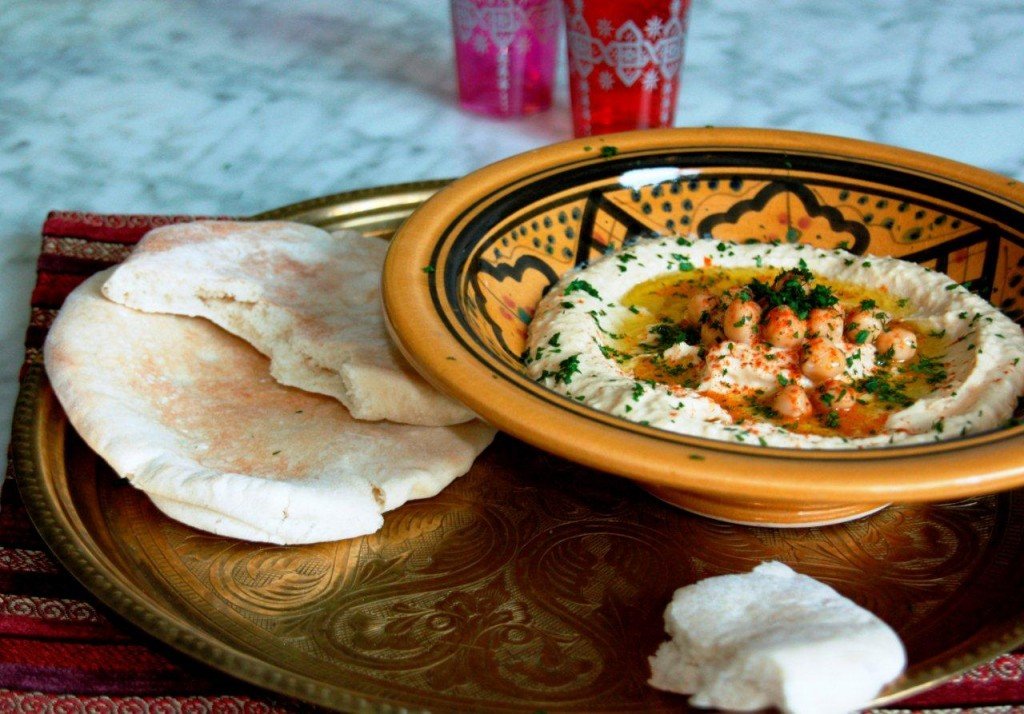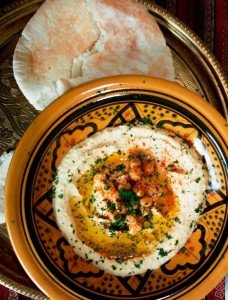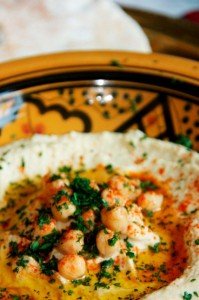The Etiquette of Hummus

I first grew to love hummus in my husband’s family home in Bethlehem, where they typically eat it for breakfast. A child from the household (usually still in pajamas) is sent to the corner shop with an empty dish in his hand. He returns with fresh Arabic bread and the dish, now filled with hummus, beautifully garnished. When I first experienced this, I found the whole process tremendously exotic.
Of course, now hummus is no longer considered “exotic.” It’s so common in the US—such standard everyday fare—that I hesitated to write about it. Then I saw in this month’s Elle Décor magazine an article featuring hummus. That inspired me!
Have you noticed that Americans tend to eat hummus as a dip with veggie sticks? The eater just randomly dips and scoops.
Not so in the Arab world. Usually it’s eaten as part of a meal or mezze spread—typically eaten communally off the same plate. But there’s a method to it.
Many times in Dubai while sharing a plate of hummus with friends, I’ve seen an eager American rip off a huge slab of Arabic bread and then swirl it like a giant tortilla chip through the hummus, treating it like a big bowl of party dip.
Honestly now. When eating Arabic-style, this can be a bit of a turn-off. Not to mention, it ruins the presentation of the dish.
If you watch Arabs eat from the same plate (whatever the dish), you’ll notice they generally eat from their own area and avoid encroaching on their neighbor’s space. For hummus, they use small, bite-size pieces of bread. They dip at the edge of the plate directly in front of them. They pop the whole thing neatly in their mouth.
Below is a hummus recipe from Najda Arabic Cookbook, a charity cookbook now out of print. (Najda means “help” in Arabic.) This recipe is marvelously easy and takes about 10 minutes. Over-achievers will prefer to soak dried chickpeas the night before. As for the rest of us, here’s an easier way:
Makes 6-8 servings
½ c liquid from canned chickpeas
2 cans (16 oz each) chickpeas, drained
4 T tahini
Juice from 2 lemons (approx. 4 T)
2 cloves garlic, pressed
1 t salt
Garnish: whole chickpeas, olive oil, paprika, and fresh chopped parsley
Place the first six ingredients in food processor. Don’t forget to reserve a few chickpeas for garnish. Blend until smooth and creamy. If too thick or pasty, add extra lemon juice.
 Serve by spreading the hummus on a shallow serving bowl or plate. Swirl the hummus to make a “moat”. Place the reserved chickpeas in the center. Generously drizzle olive oil around. The olive oil enhances the hummus and keeps it from drying out. Sprinkle a dash of paprika and chopped parsley. Other options for garnish: sumac, cumin, sliced pickles or roasted pine nuts.
Serve by spreading the hummus on a shallow serving bowl or plate. Swirl the hummus to make a “moat”. Place the reserved chickpeas in the center. Generously drizzle olive oil around. The olive oil enhances the hummus and keeps it from drying out. Sprinkle a dash of paprika and chopped parsley. Other options for garnish: sumac, cumin, sliced pickles or roasted pine nuts.
Hummus can be made ahead and garnished at the last minute. Leftovers can be refrigerated for 4-5 days.
At our house, we cannot eat hummus without sweet Arabic mint tea or fresh pita bread.
Just so you know: hummus is historically an Arabic food. If you’d like to know more, here is a history of hummus.
Finally, if you have something to say about hummus or Arabic food etiquette, please leave a comment below. Bye for now & Salaam!

 Follow
Follow
Love hummus. I’m sure I was one of those Americans who swooped into the whole bowl in your presence. Please forgive me. Now — thanks to your blog — I know better. I hope to try your recipe. xx
Yes…when hummus is done right…lovely…when it’s from the grocery–from a can (gasp), or worst of all labled “sabra” (for Gawd sakes)–NASTY. Oh, and it needs bread, good bread! Lovely post, you made me hungry.
Ah yes, I too need to ask forgiveness for my less than appropriate manners. But you have made me more aware of the proper etiquette for eating humus. Thanks friend. And thanks for the recipe as well as history!
I have loved hummus since I first tried it and there are many ways to make it. I eat it anytime I can or have the time to make it.
Salam Friends, Thanks for the comments. I should have mentioned … I, too, was one of those swirl-the-bread-all-over eaters–until someone gently corrected me. It’s one of those cultural differences–a minor one.
Hi Holly,
The habit of eating from the side closest to you comes originally from Islamic traditions. 1400 years ago people setting a table with individual plates was not an option and people shared the same plate. The Prophet advised that the proper “etiquette” would be for each person to stick to their side of the plate….I guess it seemed more hygienic given the circumstances!!
Surprisingly the way you describe the breakfast tradition in Bethlehem is identical to the breakfast traditions of Egypt (now mostly eroded). Just replace hummus with Fuul (the fava bean national dish of Egypt)!!!!
Hi Soha!! Thanks for the comment and your great insight into the history behind this custom. It makes perfect sense. Also, I appreciate your note about Egypt & ful, another favorite of mine.
good photography!
This is a great post and funny because I’ve had similar experiences when feeding Americans couscous – they shove their spoon right into the middle! Great tips on how to eat it “properly”. I think westerners assume if you’re eating with your hands it must be a free-for-all!
Thanks, Holly, for gently correcting our errant scooping! I will never approach the hummus the same way again. And a new hummus recipe, yay! A new way to feed the family addiction…
I have fond memories of chatting with you over hummus and mint tea! This recipe is similar to mine, except I add more tahini and some ground cumin. Also, I live in an area that grows garbonzo crops and, in season, we can find fresh/green ones in the local grocery stores. We love snacking on them, and when available I use those to top my hummus — it’s both attractive and tasty that way! As a side note: hummus was the first food (at 9 mos) of my middle girl (she refused anything else in anyway)!
Brilliantly written post, Holly! Succinct, thoughtful, humorous and informative…more the quality of a magazine article than the usual dribbling consciousness of many blogs. Also thanks to you, my refrigerator now has a lovely container of pine nut hummus and smells blissfully of garlic.
I shall be following your work with both enthusiasm and interest.
@zayd
Thank you, Zayd. This was my first attempt at food photography. It’s not easy making food look appetizing in a photo.
@Amanda
Amanda, Your comment about Americans think it’s a free-for-all when eating with your hands made me laugh! And I appreciated the comment about the couscous. It’s such a small thing–where to dip into the food–but it can be a cultural faux pas.
@Andrea
Andrea, Thank you for the sweet comment. It means a lot to me, as I have fond memories of those times, too. 🙂
@Natalie & @Danielle, Thank you for the kind words & positive feedback. I really appreciate your comments. Enjoy your hummus. 🙂
YUMMY!!!!
Thank you for sharing this topic on hummus.. I try to tell all my friends that Hummus is not to be eaten with Taboule, or Fattoush.. it’s an art to eat it with the right food, and the perfect piece of Arabic bread..
Brigitte,
Thanks for your comment. I agree–hummus is the perfect food. You just have to know how to eat it. 🙂
I love your site and your work and I love to share with you our family tradition for hummus. We do the same garnish but instead of adding olive oil we fry some pine nuts in butter gee (clarified butter) until they are golden color and spread them around the plate.
We pomegranates are in season we use their juice to replace lemon juice. How much is depends on the pomegranates and how sour they are. I would say one will replace the two.
I hope you try it
Hi Bakr, Thank you for your comment. I have used fried pine nuts before (delicious) but I have never tried pomegranates with hummus. I love pomegranates, so it’s something to try! Thanks again, Holly